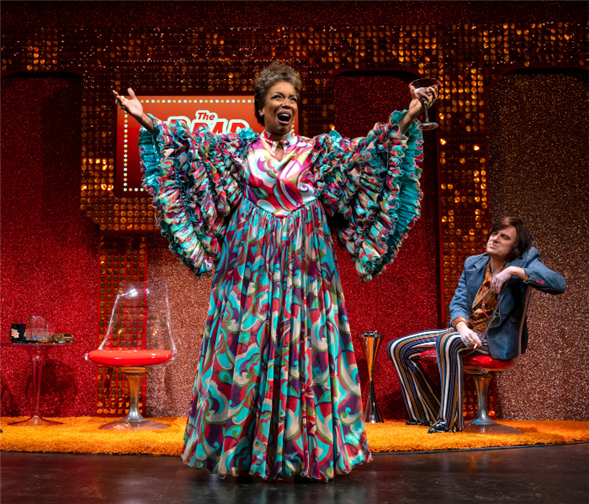Translate Page

Dede M. Ayite on crafting the costumes for the multi-era comedy By the Way, Meet Vera Stark
---
How do you give outfits subtext? That's one of the many challenges Dede M. Ayite faced designing the costumes for Signature Theatre Company's revival of Lynn Nottage's By the Way, Meet Vera Stark. The story of the titular character, a Depression-era black maid turned Hollywood actress who dreams of saying more than "yes'm," the satire skips from the '30s to the '70s to the 2000s, and Ayite's pitch-perfect period pieces help ground each era. Thematically, the show is about image versus authenticity, as the characters perform who they think they're supposed to be, both onscreen and off. Ayite's tailored designs unearth the truth behind who they really are.
Born and raised in Ghana before moving to the U.S. as a teen, Ayite always loved clothes. She even orchestrated fashion shows with her friends in high school. Yet she never thought about pursuing a creative career until she enrolled at Lehigh University, where an elective scenic painting class sparked her love for the stage. She ended up graduating with a double major in behavioral neuroscience and theatre, then studying scenic design at Yale before veering into costuming. Over the past decade, she's worked on dozens of productions, both regionally and in New York, notably with director Robert O'Hara on Slave Play, Mankind and Bella: An American Tall Tale; and director Kenny Leon on Children of a Lesser God and American Son on Broadway. Interestingly, she says her behavioral neuroscience knowledge comes in handy for her chosen profession. "I love figuring out the psyche of a character," she explains. "I'm appreciative of that background because it allows me to think through a character's action. My job is to add texture to enhance whatever is being portrayed on stage."
That's certainly apparent in Meet Vera Stark, in which many actors are double cast. Ayite's costumes not only differentiate the characters, they give insight into them, too. For example, as a Golden Age of Hollywood studio executive, actor David Turner dons a navy blue suit that could double as an undertaker's uniform, and though he supposedly wields all the power in the room, he is a touch too small for the clothing he wears. Then there's Gloria (Jenni Barber), the '30s movie star who employs Vera as a maid. At a boozy dinner party, Gloria's red velvet, feathered gown reflects the garish vulture beneath her "America's little sweetie-pie" persona. And of course, the transformation of Vera (Jessica Frances Dukes) from real-life servant to movie slave to psychedelic '70s diva is immeasurably aided by Ayite's work, which divulges telling details about her journey.
Research into the script and conversations with the director "about the trajectory of a character and how we can layer their needs" are what drive Ayite's creative process. "The text is sort of like the Bible -- whatever the writer has put out there gives me my ammunition to leap forward," she explains. "When I go shopping for fabrics for a character, I'm acknowledging how that character needs to inhabit the clothing. I keep that in the back of my mind as I'm sketching."
With Vera Stark, Ayite had a rich arc for inspiration. Act I takes place in the '30s, with a young Vera usually in a crisp maid's uniform or a Southern green spring dress. But in the second half set 40 years later, she appears on a TV talk show resplendent in a swirling peacock dress, beaming like the sexy earth mama she had always wanted to play. It's an outrageous reintroduction to someone we thought we knew, and it feels entirely natural as a manifestation of Vera's evolution.
"It's another level in showcasing who you are, right?" says Ayite. "Vera didn't have a ton of money, however she was a woman who was into style. The person she was working for used to wear a lot of furs and had all the Hollywood glamour. As a human being that sits with you. So how does that stay with Vera? When we see her in the '70s, my intention was to show all of the things that her character might have desired earlier in her career. Her outfit is quite over-the-top; it's very colorful. It has layers and lots of ruffles because it's her expressing herself through her clothing. She's able to do that, finally, in a different way because she's attained a level of success compared to when we first met her."
Meet Vera Stark is Ayite's fifth New York production this season, and her sixth, If Pretty Hurts Ugly Must Be a Muhfucka at Playwrights Horizons, is currently in previews. Plus she's already got at least one fall show lined up: She was just announced as part of the creative team for The New Englanders at Manhattan Theatre Club, which will be directed by her frequent collaborator Saheem Ali. Clearly there's a reason these directors keep asking her back. But she's very modest about what she does, and quick to give credit to others for making her look good: "A costume is just a piece of clothing without a human being in it to make it come alive."
To read about a student's experience at By the Way, Meet Vera Stark, check out this post on TDF's sister site SEEN.
---
A dancer and playwright, Juan Michael Porter II has contributed articles to Ballet Review, The Dance Enthusiast, Time Out New York, Broadway World and HuffPost. Follow him at @juanmichaelii. Follow TDF at @ TDFNYC.
Top image: Jessica Frances Dukes and Manoel Felciano in By the Way, Meet Vera Stark. Photos by Joan Marcus.
TDF MEMBERS: Go here to browse our latest discounts for dance, theatre and concerts.